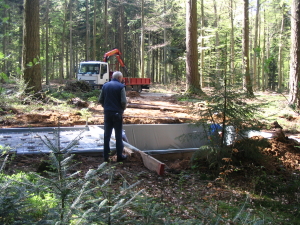Vielsalm Terrestrial Observatory
The terrestrial observatory of Vielsalm has been installed in 1996 thanks to fundings of European Community and Fonds National de la Recherche Scientifique (FNRS-FRS). Flux (eddy covariance) and micrometeorological measurements are preformed continuously since more than 15 years and constitute one of the longest and the most complete data series in Europe. Until 2009, measurements were made at the top of a 40 m height scaffolding tower. In 2009, the tower was replaced by a 52 m pylon.
The site was/is a part of the European Euroflux, CarboEuroflux, CarboEurope, IMECC networks and of the worldwide FLUXNET network.
During the successive measurement years, several complementary campaigns have been organised : forest inventory, automatic soil respiration measurements, , advection, ecosystem water budget (in collaboration with Université Catholique de Louvain), diffusion of CO2 and stable isotopes in soil (in collaboration with INRA Nancy and University of Fribourg), volatile organic compounds fluxes (collaboration with Beligan Institute of Spatial Aeronomy and University of Ghent), soil carbon content inventory (Max Planck Institute for Biogeochemistry, Jena), monthly evolution of nitrogen deposition (Nitroeurope).
In addition to site specific publications, these measurements were used in the frame of the study of the impact of the 2003 heat wave on the European carbon balance (Ciais et al., 2005), which describes how terrestrial ecosystems may be perturbated by a climatic anomaly.
Besides this the measurements were integrated in the frame of the CarboEurope network in order to establish a first assesment of European terrestrial carbon balance.
The site is planned to integer the European ICOS network in 2012.



